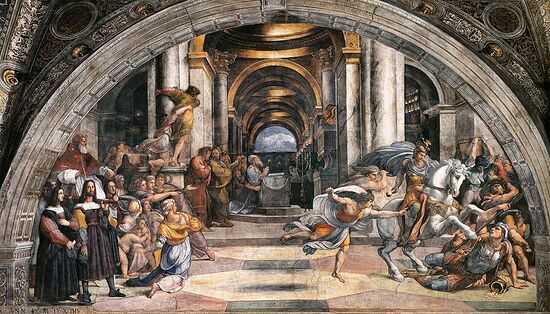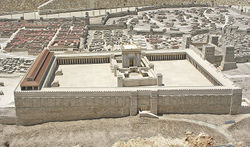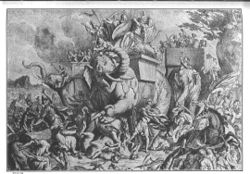Difference between revisions of "Category:Tigranes the Great (subject)"
| Line 1: | Line 1: | ||
{| style="margin-top:10px; background:none;" | |||
| style="background:white; width:65%; border:1px solid #a7d7f9; vertical-align:top; color:#000; padding: 5px 10px 10px 8px; -moz-border-radius: 10px; -webkit-border-radius: 10px; border-radius:10px;" | | |||
<!-- ===================== COLONNA DI SINISTRA ==================== --> | |||
{| cellpadding="2" cellspacing="5" style="width:100%; vertical-align:top; background:transparent;" | |||
{{WindowMain | |||
|title= Tigranes the Great / Armenian Invasion | |||
|backgroundLogo= Bluebg_rounded_croped.png | |||
|logo= Logo.png | |||
|px= 38 | |||
|content= [[File:Heliodorus Raphael.jpg|550px]] | |||
| Line 6: | Line 16: | ||
*Page created and edited by [[Gabriele Boccaccini]], University of Michigan | *Page created and edited by [[Gabriele Boccaccini]], University of Michigan | ||
== | }} | ||
{{WindowMain | |||
|title= Tigranes the Great -- Overview | |||
|backgroundLogo= Bluebg_rounded_croped.png | |||
|logo = logo.png | |||
|px= 38 | |||
|content= | |||
Under Tigranes' leadership, Armenia became for a short time the strongest empire in the Middle East and a menace to Roman power in the region. | Under Tigranes' leadership, Armenia became for a short time the strongest empire in the Middle East and a menace to Roman power in the region. | ||
| Line 22: | Line 38: | ||
The campaigns of the Roman general [[Lucullus]] largely reduced Tigranes' power in the region. The empire Tigranes had created collapsed, the new capital had to be abandoned. Tigranes took refuge to the mountains of Armenia, yet still undefeated, in spite of the attempts by Lucullus to chase him. Tigranes ultimately surrendered to [[Pompey]] in 66 BCE, receiving in exchange permission to rule Armenia as an ally of Rome, until his death in 55/54 BCE. | The campaigns of the Roman general [[Lucullus]] largely reduced Tigranes' power in the region. The empire Tigranes had created collapsed, the new capital had to be abandoned. Tigranes took refuge to the mountains of Armenia, yet still undefeated, in spite of the attempts by Lucullus to chase him. Tigranes ultimately surrendered to [[Pompey]] in 66 BCE, receiving in exchange permission to rule Armenia as an ally of Rome, until his death in 55/54 BCE. | ||
'''Tigranes and the Jews''' | |||
When in 69 BCE Tigranes' army moved south to Phoenicia, the Hasmonean Queen [[Salome Alexandra]] submitted and paid tribute, receiving only vague promises in return. After the taking of Ptolemais, Israel was next in line, facing imminent invasion, defenseless against Tigranes' army. Only the intervention of the Roman general Lucullus in Syria saved the Hasmonean State from total capitulation and forced Tigranes to withdraw. | When in 69 BCE Tigranes' army moved south to Phoenicia, the Hasmonean Queen [[Salome Alexandra]] submitted and paid tribute, receiving only vague promises in return. After the taking of Ptolemais, Israel was next in line, facing imminent invasion, defenseless against Tigranes' army. Only the intervention of the Roman general Lucullus in Syria saved the Hasmonean State from total capitulation and forced Tigranes to withdraw. | ||
| Line 28: | Line 44: | ||
In an ironic reversal of fortune, two descendants of Queen [[Salome Alexandra]], namely, [[Tigranes V]] (6-12 CE) and [[Tigranes VI]] (58-62 CE), would rule in the first century CE as Kings of Armenia and successors of that [[Tigranes the Great]], who once was on the verge of destroying the Hasmonean kingdom and dynasty. | In an ironic reversal of fortune, two descendants of Queen [[Salome Alexandra]], namely, [[Tigranes V]] (6-12 CE) and [[Tigranes VI]] (58-62 CE), would rule in the first century CE as Kings of Armenia and successors of that [[Tigranes the Great]], who once was on the verge of destroying the Hasmonean kingdom and dynasty. | ||
'''Tigranes the Great in literature & the Arts''' | |||
Tigranes might be the "Nebuchadnezzar" of the Book of Judith, whose invasion threatened the independence of the Judean State and was opposed only by the courage of a devout and strong widow ([[Judith]] = [[Salome Alexandra]]). | Tigranes might be the "Nebuchadnezzar" of the Book of Judith, whose invasion threatened the independence of the Judean State and was opposed only by the courage of a devout and strong widow ([[Judith]] = [[Salome Alexandra]]). | ||
| Line 44: | Line 56: | ||
[NOTE – Contrary to what is often claimed, ''Il Tigrane; ovvero, L’egual impegno d’amore e di fede'' (Teatro San Bartolomeo, Naples, 1715) by Alessandro Scarlatti (with libretto of Domenico Lalli [pseud. for Sebastiano Biancardi]) does not deal with the same subject but with the sixth-century BCE Armenian King Tigranes. The same libretto was set to music by [[Tomaso Albinoni]], under the title ''L’amor di figlio non conosciuto'' (Teatro Sant’Angelo, Venice 1715).] | [NOTE – Contrary to what is often claimed, ''Il Tigrane; ovvero, L’egual impegno d’amore e di fede'' (Teatro San Bartolomeo, Naples, 1715) by Alessandro Scarlatti (with libretto of Domenico Lalli [pseud. for Sebastiano Biancardi]) does not deal with the same subject but with the sixth-century BCE Armenian King Tigranes. The same libretto was set to music by [[Tomaso Albinoni]], under the title ''L’amor di figlio non conosciuto'' (Teatro Sant’Angelo, Venice 1715).] | ||
====Related categories==== | |||
== | |||
== | |||
*[[Salome Alexandra]] | *[[Salome Alexandra]] | ||
==External links== | ====External links==== | ||
*[http://en.wikipedia.org/wiki/Tigran_the_great Wikipedia] | *[http://en.wikipedia.org/wiki/Tigran_the_great Wikipedia] | ||
| Line 65: | Line 71: | ||
*[http://www.armenians.com/famous/Tigran/Mvc-791s.jpg Modern Armenian Coin dedicated to Tigranes] <armenians.com> | *[http://www.armenians.com/famous/Tigran/Mvc-791s.jpg Modern Armenian Coin dedicated to Tigranes] <armenians.com> | ||
}} | |||
{{WindowMain | |||
|title= Ancient Sources | |||
|backgroundLogo= Bluebg_rounded_croped.png | |||
|logo = contents.png | |||
|px= 38 | |||
|content= | |||
}} | |||
|} | |||
|<!-- SPAZI TRA LE COLONNE --> style="border:5px solid transparent;" | | |||
<!-- ===================== COLONNA DI DESTRA ==================== --> | |||
| style="width:35%; border:1px solid #a7d7f9; background:#f5faff; vertical-align:top; padding: 5px 10px 10px 8px; -moz-border-radius: 10px; -webkit-border-radius: 10px; border-radius:10px;"| | |||
{| id="mp-right" cellpadding="2" cellspacing="5" style="width:100%; vertical-align:top; background:#f5faff; background:transparent;" | |||
{{WindowMain | |||
|title= [[Second Temple Studies]] | |||
|backgroundLogo= Bluebg_rounded_croped.png | |||
|logo= contents.png | |||
|px= 38 | |||
|content= [[File:Second Temple.jpg|250px]] | |||
}} | |||
{{WindowMain | |||
|title= [[Maccabees]] | |||
|backgroundLogo= Bluebg_rounded_croped.png | |||
|logo= contents.png | |||
|px= 38 | |||
|content= [[File:Maccabees Picart.jpg|250px]] | |||
}} | |||
{{WindowMain | |||
|title= Some Works of Art | |||
|backgroundLogo= Bluebg_rounded_croped.png | |||
|logo = contents.png | |||
|px= 38 | |||
|content= | |||
[[File:Heliodorus Flemal.jpg|thumb|left|200px|[[Expulsion of Heliodorus from the Temple (1662 Flémal), art]]]] | |||
}} | |||
|} | |||
|} | |||
* [[Tigranes the Great (sources)]] | |||
[[Category:Index (database)]] | [[Category:Index (database)]] | ||
[[Category:People (database)]] | [[Category:People (database)]] | ||
Revision as of 08:24, 29 January 2016
|
Tigranes the Great / Armenian Invasion
Tigranes the Great -- Overview Under Tigranes' leadership, Armenia became for a short time the strongest empire in the Middle East and a menace to Roman power in the region. At its height, the Armenian Empire included the regions of Media, Assyria, Cappadocia, Cilicia, Syria, Phoenicia, and Palestine. Tigranes took the title "King of Kings" for himself and ruled as a new Nebuchadnezzar, surrounded by the deposed kings who had to serve him. The beginnings of Tigranes' rule, however, were very hard. In his youth he lived hostage at the court of the Parthian King Mithridates the Great. Only around 95 BCE he bought back his freedom by handing over “seventy valleys” to the Parthians. He rapidly built up an alliance with another ambitious and powerful neighbor, the King Mithridates of Pontus and married his daughter Cleopatra. In 88 BCE, at the death of King Mithridates II of Parthia, Tigranes took advantage of the weakness of the Parthian empire to expand his influence in the East. He went so far as to attack the Parthian capital Ecbatana and looted it around. After concluding successfully his military campaign in the East, Tigranes, who now could legitimately bear the Parthian title of “King of Kings,” around 83 BCE moved westwards, conquering the Seleucid empire, Syria and Cilicia. He moved the capital of his empire from Artashat in Armenia to the newly founded city of Tigranocerta, that he populated by deporting inhabitants from the conquered lands. He then pushed south conquering Phoenicia. In 69 BCE he reached and besieged the seacoast city of Ptolomais (Acca), the last Seluecid stronghold at the border with the Hasmonean kingdom. The other populations of the region, including the Hasmonean kingdom, quickly submitted to the invader. But when the victory over Ptolomais opened the path to the conquest of Judea and Egypt, the Romans intervened. Tigranes entered in conflict with the Romans. It happened that Mithridates of Pontus, his father-in-law and alley, had been defeated by the Romans and had sought asylum in Armenia. Tigranes refused to deliver him. Rome declared war and Tigranes was forced to withdraw his garrisons from Syria as the general Lucullus attacked the capital Tigranocerta. The campaigns of the Roman general Lucullus largely reduced Tigranes' power in the region. The empire Tigranes had created collapsed, the new capital had to be abandoned. Tigranes took refuge to the mountains of Armenia, yet still undefeated, in spite of the attempts by Lucullus to chase him. Tigranes ultimately surrendered to Pompey in 66 BCE, receiving in exchange permission to rule Armenia as an ally of Rome, until his death in 55/54 BCE. Tigranes and the Jews When in 69 BCE Tigranes' army moved south to Phoenicia, the Hasmonean Queen Salome Alexandra submitted and paid tribute, receiving only vague promises in return. After the taking of Ptolemais, Israel was next in line, facing imminent invasion, defenseless against Tigranes' army. Only the intervention of the Roman general Lucullus in Syria saved the Hasmonean State from total capitulation and forced Tigranes to withdraw. In an ironic reversal of fortune, two descendants of Queen Salome Alexandra, namely, Tigranes V (6-12 CE) and Tigranes VI (58-62 CE), would rule in the first century CE as Kings of Armenia and successors of that Tigranes the Great, who once was on the verge of destroying the Hasmonean kingdom and dynasty. Tigranes the Great in literature & the Arts Tigranes might be the "Nebuchadnezzar" of the Book of Judith, whose invasion threatened the independence of the Judean State and was opposed only by the courage of a devout and strong widow (Judith = Salome Alexandra). In Armenia Tigranes has never ceased to be celebrated in the arts as a hero of national pride and independence. With the renewed independence of the Armenian Republic in 1991, the figue of Tigranes has gained, if possible, even more relevance in Armenian culture and public life. In 1991 the play “Agony of Tigranes the Great” (1991) staged at Yerevan by actor Vartan Garniki, based on a patriotic poem of Hovhannes Shiraz (1915-1984) was celebrated as one of a landmarks in the awakening of Armenian national pride. To Tigranes the Great the new State has dedicated a monumental statue at Yerevan, a golden coin (1999), and a stamp (2007). In the West, Tigranes knew a brief period of revival and popularity only at the turn of the eighteenth century. He was the protagonist of Il Tigrane, re d’Armenia / Tigranes, King of Armenia, a libretto written by Francesco Silvani in 1691 and revised by Carlo Goldoni in 1741. Between 1691 and 1766, the libretto was set to music by more than 20 composers, including Tomaso Albinoni, Antonio Vivaldi, Adolph Hasse, Christoph Gluck, Niccolò Piccinni, and others. The fictional story, however, focused on the love relationship between the Armenian king and his wife Cleopatra, the daughter of Mithridates, and did not contain any reference to the military campaign of Tigranes in Phoenicia and Judea. [NOTE – Contrary to what is often claimed, Il Tigrane; ovvero, L’egual impegno d’amore e di fede (Teatro San Bartolomeo, Naples, 1715) by Alessandro Scarlatti (with libretto of Domenico Lalli [pseud. for Sebastiano Biancardi]) does not deal with the same subject but with the sixth-century BCE Armenian King Tigranes. The same libretto was set to music by Tomaso Albinoni, under the title L’amor di figlio non conosciuto (Teatro Sant’Angelo, Venice 1715).] Related categoriesExternal linksPictures from the web
Ancient Sources |
Some Works of Art
|
Pages in category "Tigranes the Great (subject)"
The following 7 pages are in this category, out of 7 total.
1
- Tigran the Great (1940 Armen), book
- Tigran B. yev Hrome (1940 Manandyan), book
- Тигран второй и Рим (1943 Manandyan), book (Russian ed.)
- Tigrane II & Rome (1963 Manandyan), book (French ed.)
- Hoard of Copper Coins of Tigranes the Great (1991 Bedoukian), book
- Roma - Armenia (1999 Mutafian), edited volume



